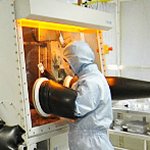Centre for Organic Photonics & Electronics (COPE)
The University of Queensland
COPE undertakes the development of organic semiconductor materials and their application in next generation electronic and optical devices. The centre has expertise in computational studies of materials, synthesis, materials characterisation (physical, electronic and photophysical) and prototype device fabrication and testing. The centre has key programs in photovoltaics (electricity generation), lighting, and the detection of chemical threats including narcotics, explosives, toxic industrial chemicals and chemical warfare agents. Its research programs include basic science as well as translation of technologies to industry.
- Website
- https://cope.centre.uq.edu.au/
- Organisation type
- University Research Centre
- Number of research staff
- 20-100 research staff
- Address
- Level 9, Building 68, Cooper Rd, The University of Queensland QLD 4072
Strengths and capabilities
- Computational chemistry relating to organic semiconductor materials and thin films
- Synthesis of organic semiconductor materials including small molecules, dendrimers, polymers and poly(dendrimer)s
- Materials characterisation
- Spectroscopic analysis of materials using steady state and ultrafast techniques
- Charge transport measurements
- Device prototyping and testing
- Commercialisation of technologies
Facilities and major equipment
- Synthetic chemistry laboratory with 19 fumehoods and associated equipment required for synthesis and purification of organic semiconductor materials
- Electrochemical Analyser
- Thermal gravimetric analysis and differential scanning calorimetry
- Charge transport measurement suite
- Absorption and fluorescence spectrometers
- Ultrafast spectroscopy suite featuring transient absorption spectrometer, streak camera, and fluorescence up-conversion instruments
- Class 1000 cleanroom
- Device fabrication tools including Angstrom and two separate Kurt J Lesker evaporation systems with integrated gloveboxes, including for solution processing organic semiconductor inks
Lead researchers
- Professor Paul Burn FAA FRACI FRSC is a UQ Laureate Fellow
- Dr Paul Shaw is a UQ senior lecturer in physical chemistry
- Professor Ian Gentle is a UQ professor in physical chemistry
Achievements of the centre
- The first example of unambiguous differentiation of G- and V-series nerve agents using fluorescence detection (Small Methods, 2023)
- Increased performance and stability of perovskite solar cells using fluorinated additives (Nature Communications, 2021)
- Fluorescence-based detection of narcotics using perylenediimide-based thin films (Advanced Functional Materials, 2024)
- Revealing the interplay between morphology, charge transport and luminescence efficiency in OLEDs (Advanced Functional Materials, 2020)
- Controlling the dielectric constants of organic semiconductor materials for solar cells (PhysChemChemPhys, 2023)
Key science sectors
More information about the sectors this centre is involved in:
Update details
Is this your centre? See any issues? Send a request to update your listing.
